“From my first fight I started to run away.”
James John Corbett, often referred to as “Gentleman Jim,” never cared much for the brutish nature of the sport of boxing. In fact, even before the future champion ever learned to box, his natural instinct in school-yard fights at the age of twelve was to stick and move. Eventually expelled from school for fighting at age thirteen, it didn’t take long for Corbett to find his way into the pugilistic world. It was at the Olympic Athletic Club in San Francisco that the young “Gentleman Jim” received his first formal training, with Englishman Walter Watson instilling the rudiments that Corbett would use to succeed as a ringman.
A banker by day and an amateur boxer by night, it was not long before “Gentleman Jim” became recognized as the Olympic Club’s middleweight and heavyweight champion, as he even took on several accomplished professionals in exhibition bouts. Among those was future middleweight champion Jack Dempsey, “The Nonpareil”, who Corbett surprised by giving as good as he got for the thirty minutes of intense combat they engaged in.
Corbett began his pro career in Salt Lake City when a young Jim, struggling to pay rent, decided to use his boxing skills to make ends meet. Corbett fought twice in Utah before moving back to San Francisco, but chose to work for an insurance company rather than continue punching for pay. However, it didn’t take long for the fisticuffs to recapture Jim’s imagination, as an old amateur rival with a big punch by the name of Joe Choynski was making a name for himself.
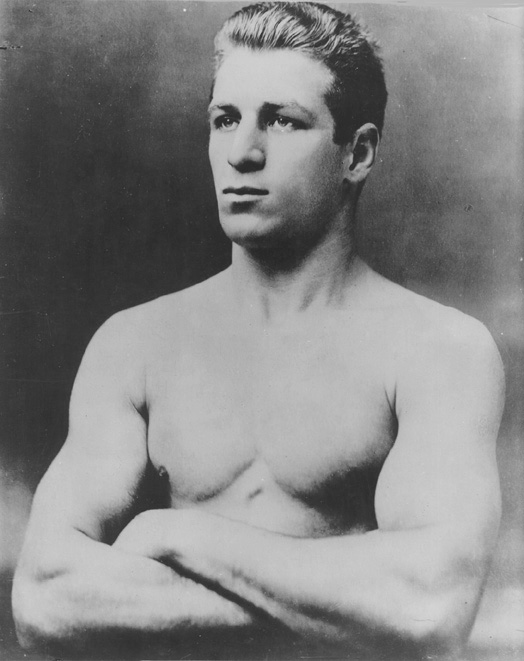
Corbett and Choynski squared off for the first time as professionals on May 30th, 1889 in Fairfax California. The two battled at a tremendous pace for six rounds before the action was halted by the local sheriff, who advised them that they would have to continue their tilt in a different jurisdiction. Six days later, in a different county, Corbett and Choynski finally settled the score. But Corbett came into the rematch with several handicaps. Not only was the Irishman standing on badly blistered feet, but Corbett was also fighting with a compromised right hand that he had injured in the first bout. Corbett would later claim he never used his right hand once during the return.
A wounded lion can be dangerous though, especially with a fighter as resourceful as “Gentleman Jim.” Unable to use his right, Corbett improvised with his left in a manner previously unbeknownst to the boxing world, namely a lead left hook. It was with this very shot that Corbett put an end to the battle in round twenty-eight after nearly being out himself in the fifteenth. In his autobiography, The Roar of the Crowd, Corbett states that his struggle with Choynski was the “toughest battle that I had ever fought or was to fight.”

Corbett’s next major match came in New Orleans against Jake Kilrain, the man who previously held heavyweight champion John L. Sullivan to the 75th round in the last bareknuckle heavyweight championship fight in history. Over the course of their six-round affair, the 23-year-old Corbett out-boxed, out-smarted, and out-fought the older, more experienced Kilrain, who left the ring battered and cut. Corbett won the decision and following the match the locals in New Orleans celebrated the young Irishman as the next heavyweight champion of the world. But perhaps more importantly was the fact that Corbett’s father, who long opposed his son’s decision to become a prizefighter, now showed pride in the younger man’s ring accomplishments.
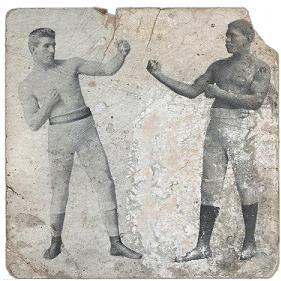
It was not long after the Kilrain victory that one Peter Jackson began his tour of San Francisco, and this soon led to some bad blood between the cocky “Black Prince” and the proud Corbett. Naturally, their animosity towards one another manifested itself in a $10,000 prizefight held in the California Athletic Club in San Francisco. And there can be no doubt, this would prove to be Corbett’s toughest test to date.
Despite claiming he could “lick any son-of-a-bitch in the house,” the widely recognized world heavyweight champion John L. Sullivan had denied Jackson a title shot because he happened to be black. Regardless of whether Sullivan was just sticking to his racist principles or was running scared, very few doubted the fact that Jackson was one of the best boxers in the world, having dominated most of his competition in the US, Australia, and England. Thus, Corbett was the underdog, but he exuded nothing but confidence right up to the opening bell. In fact, “Gentleman Jim” went so far as to deny Jackson his wish to enter the ring second, angering “The Black Prince” and likely giving Corbett the psychological edge before the first bell even sounded.
Early on, Corbett used all the craftiness he could muster to thwart Jackson’s offense. In particular, Jim made use of his quick feet, clever head movement, and even his front shoulder to prevent Jackson from getting set. Jim was able to steer clear of danger until round sixteen when Jackson had Corbett badly hurt with a right to the body, which Corbett later said sent a chill through his whole body. While he managed to pull himself out of danger, it was clear Corbett would need to modify his tactics if he was to find a way back into the fight.
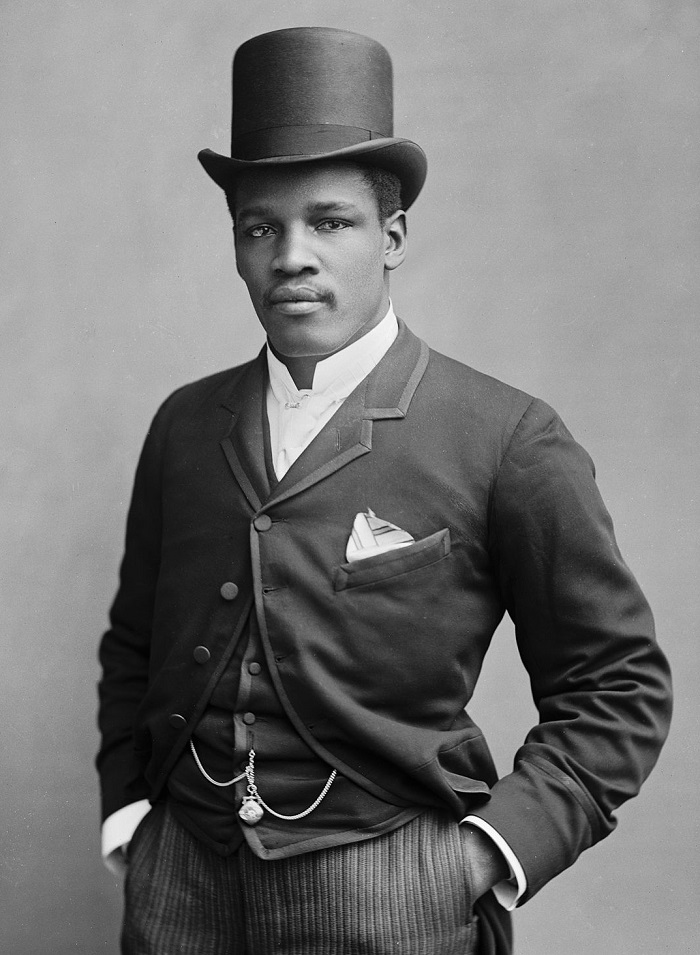
The turning point came in round twenty-five as Corbett, who was nearly out from a right hand by Jackson, managed to drive the larger man to the ropes with a barrage of punches that Jackson had no answer to. But from that point on both fighters were simply too exhausted to exchange and in round sixty-one the referee ended the contest and declared it a draw. Despite not securing the win, Corbett earned the respect of the boxing world by battling to a stalemate one of the most revered fighters in the game.
Corbett was surely in line now for a chance at Sullivan’s world championship, but his place in line relative to fellow contenders Frank Slavin and Charley Mitchell was up to the champion’s discretion. Ultimately, Corbett succeeded in getting his shot at the title thanks to a $10,000 side-bet made by Corbett’s manager William A. Brady, who also agreed to Sullivan’s winner-take-all request.
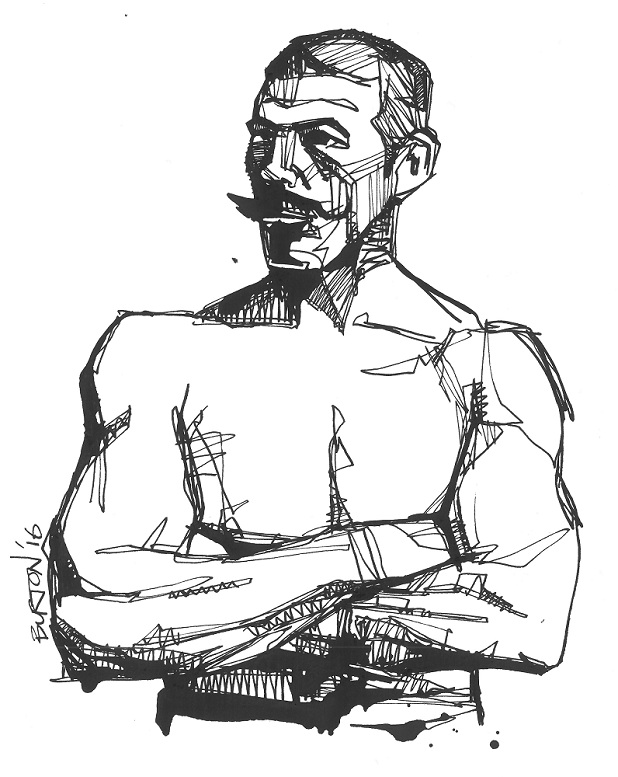
That led to Corbett’s chance to battle Sullivan for the world title in a match which, in many respects, parallels the famous fight between Muhammad Ali and Sonny Liston. Sullivan, like Liston, was universally recognized as one of the most feared men in the world and was a prohibitive favorite to successfully defend his title. Corbett, like Ali, never gave the champion the respect the undefeated Sullivan was accustomed to, as the challenger came into the ring determined to upset the odds. On the day of the fight, the younger man got under Sullivan’s skin by tricking John L. into entering the ring before him. “After you, John L.,” said Corbett to Sullivan when he eventually made his way to the ring, his taunt infuriating the champion.
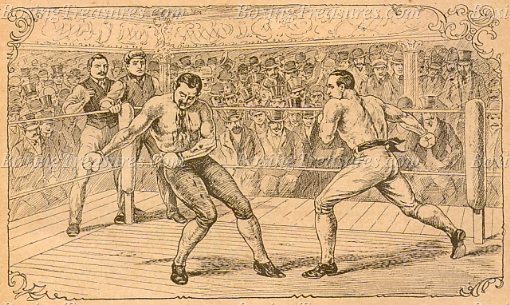
Corbett used the early rounds to get acquainted with the champion’s rough-house tactics and aggressive approach, his footwork and head movement keeping himself out of harm’s way. In the third, Corbett made his first major statement of the fight when he jarred Sullivan with a straight left that broke the champion’s nose. For the next seventeen rounds, Corbett was the matador to Sullivan’s bull-like style as he effectively side-stepped and countered the aggressive champion. Then, in round twenty-one, Corbett feinted Sullivan out of position and landed a left hook which had “The Boston Strong Boy” in a daze. The challenger immediately took the fight to Sullivan and pounded the champion to his knees. Sullivan got up, but before long Corbett put him down again, this time flat on his face. Ten seconds later, “Gentleman Jim” was the heavyweight champion of the world.
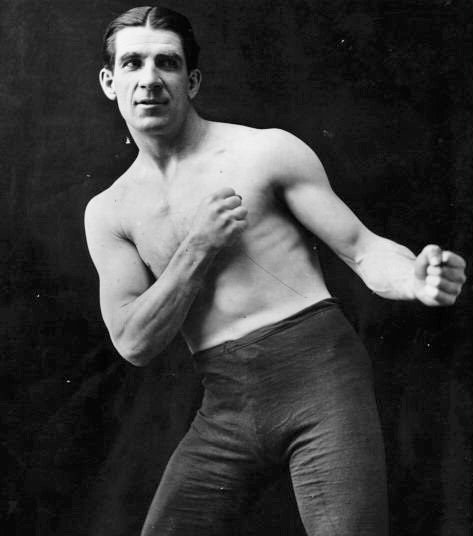
Corbett was not the most active of heavyweight kings, fighting just twice in the four years he held the crown. Despite an impressive third round knockout of Charley Mitchell in Jacksonville, Florida, Corbett’s title reign was best remembered for the famous solar plexus punch that Bob Fitzsimmons used to dethrone him in Carson City, Nevada. Corbett desperately tried to get to his feet but was counted out while fully cognizant. It was a tough situation for a proud pugilist to be in, no longer champion of the world but conscious enough to feel the pain and humiliation as Fitzsimmons celebrated nearby. Corbett, in fact, accosted “The Fighting Blacksmith” and demanded a rematch, telling the new champion that he would have to face him again or “I’ll lick you every time I meet you on the street.” To which Fitzsimmons coolly replied, “If you ever hit me, I’ll shoot you.” The threat effectively closed the book on their rivalry.
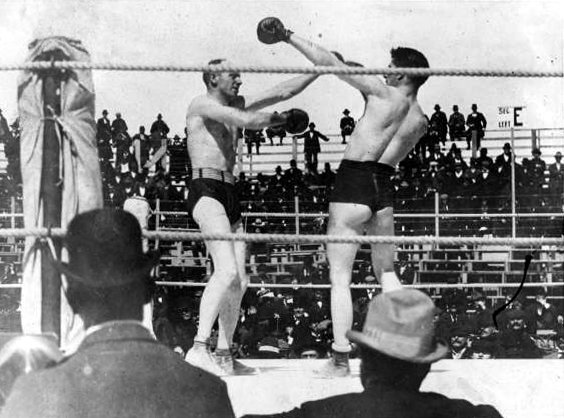
Corbett’s last great performance came in defeat against heavyweight champion Jim Jeffries. Jeffries, once Corbett’s sparring partner, eventually reached the same heights as his former mentor when he knocked out Fitzsimmons to win the title. It wasn’t surprising that Corbett was not given much of a chance against “The Boilermaker,” especially given that he was coming off a year of inactivity and consecutive defeats to Tom Sharkey and Fitzsimmons.
However, many consider this to be “Gentleman Jim’s” finest hour. He danced, he countered, he landed nearly at will, and he busted up the champion to secure a clear advantage through twenty-two rounds. With just three rounds to go in the 25-round bout, Corbett later claimed he was already envisioning electric posters in the streets proclaiming him the re-crowned heavyweight king. That is, until a thudding left hook to the jaw short-circuited those electric posters in his head and put him on the floor. For the first time in his career, Corbett was rendered unconscious in one of the all-time great one-punch knockouts.
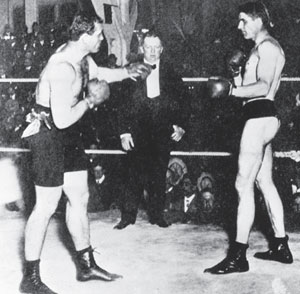
Source link





















